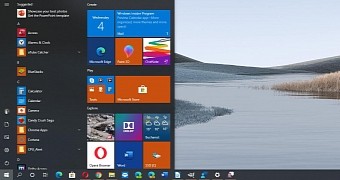The days of live tiles in Windows 10 are probably numbered, as more and more evidence seems to be suggesting that Microsoft will at one point pull them completely from the operating system.
Live tiles landed in Windows 10 when the company released the first version of the OS back in 2015, and they are borrowed from Windows Phone, the mobile platform that everyone but Microsoft really loved.
The live tiles are dynamic icons that can be used to display app information without the need for opening the app – for example, the Weather app live tiles shows data like the current temperature and the forecast without you having to launch the app.
But more recently, it has emerged that Microsoft is looking into removing live tiles from Windows 10 because few people use it, so the future of the Start menu could basically come down to a significantly simplified version that is more or less similar to the one in Windows 10X.
There are three reasons live tiles failed to gain traction in Windows 10, and all of these mean Microsoft can remove them at any point without too many people missing them in the first place.
The limited success of the Microsoft Store
Live tiles only support modern apps that are published in the Microsoft Store, and given not everyone uses these, it goes without saying that the adoption of live tiles has been impacted as well.
Microsoft has been insisting for Store apps for many years already, but up to this point, it’s very clear that they can’t replace Win32 programs. So going forward, live tiles don’t make much sense, especially because most users stick with the Win32 side of the OS.
Not all apps support live tiles
As if the limited number of apps published in the Microsoft Store wasn’t already a problem, live tiles aren’t even supported by all apps that are available for download.
So even if you head over to the Microsoft Store and download an app, there’s no guarantee it’d come with a live tile as well. The lack of support from the developer community is something that has previously plagued Windows Phone and Windows 10 Mobile as well, and by the looks of things, nothing would change on the desktop either.
They make more sense on mobile
While live tiles are great, being often considered a modern replacement to the static icons that we already have in Windows, they make much more sense on mobile for various reasons.
For example, on Windows Phone, the mobile OS that Microsoft has already killed, live tiles allowed you to see the information that I told you about earlier just by looking at the home screen.
In Windows 10, on the other hand, the live tiles are grouped under the Start menu, so you technically have to launch the Start menu and keep it open until the live tiles refresh to see the information they provide. This isn’t necessarily the most convenient approach, and for some, it could actually feel rather slow, especially when all they want is to launch the Start menu, click an app, and that’s it.
Microsoft says live tiles are here to stay, but this can obviously change overnight at any moment. The upcoming Windows 10 version 2004, which is projected to launch in the spring, won’t bring any changes related to live tiles – the development of this version has already been finalized last December and it’s now just a matter of time until the rollout to production devices starts.

 14 DAY TRIAL //
14 DAY TRIAL //